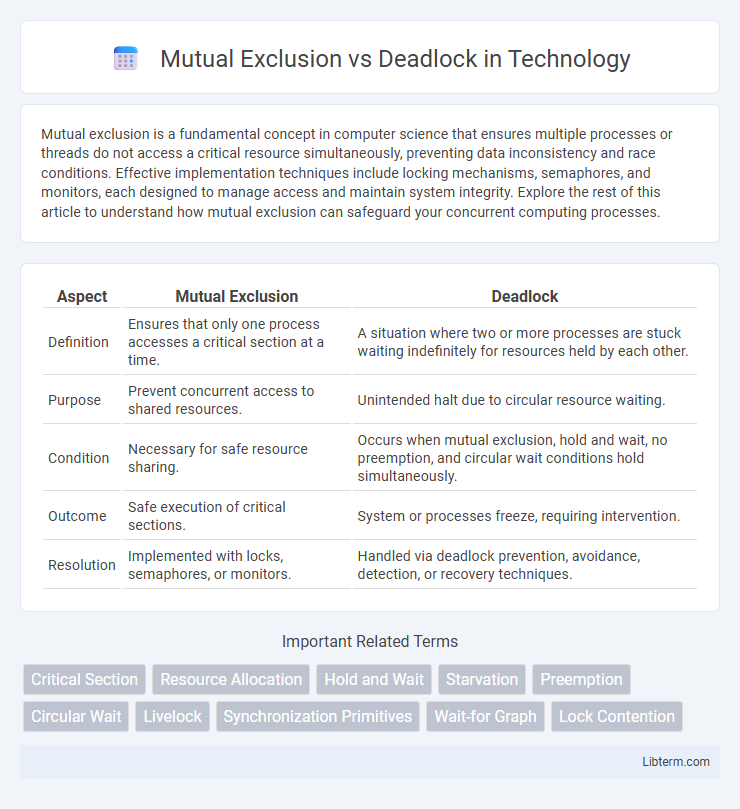Mutual exclusion is a fundamental concept in computer science that ensures multiple processes or threads do not access a critical resource simultaneously, preventing data inconsistency and race conditions. Effective implementation techniques include locking mechanisms, semaphores, and monitors, each designed to manage access and maintain system integrity. Explore the rest of this article to understand how mutual exclusion can safeguard your concurrent computing processes.
Table of Comparison
| Aspect | Mutual Exclusion | Deadlock |
|---|---|---|
| Definition | Ensures that only one process accesses a critical section at a time. | A situation where two or more processes are stuck waiting indefinitely for resources held by each other. |
| Purpose | Prevent concurrent access to shared resources. | Unintended halt due to circular resource waiting. |
| Condition | Necessary for safe resource sharing. | Occurs when mutual exclusion, hold and wait, no preemption, and circular wait conditions hold simultaneously. |
| Outcome | Safe execution of critical sections. | System or processes freeze, requiring intervention. |
| Resolution | Implemented with locks, semaphores, or monitors. | Handled via deadlock prevention, avoidance, detection, or recovery techniques. |
Understanding Mutual Exclusion
Mutual exclusion is a fundamental concept in concurrent programming that ensures only one process or thread accesses a critical section or shared resource at a time, preventing race conditions and data inconsistencies. It is typically implemented using synchronization mechanisms such as mutex locks, semaphores, or monitors to control access and maintain system stability. Understanding mutual exclusion is essential to avoid deadlocks, where two or more processes are perpetually waiting for each other's resources, causing system halt.
Defining Deadlock in Computing
Deadlock in computing occurs when two or more processes are each waiting for the other to release resources, causing an indefinite standstill. This state arises from four necessary conditions: mutual exclusion, hold and wait, no preemption, and circular wait. Understanding deadlock is crucial for managing resource allocation and ensuring system reliability in concurrent processing environments.
Key Differences: Mutual Exclusion vs Deadlock
Mutual exclusion is a fundamental synchronization principle ensuring that multiple processes do not simultaneously access a critical section of shared resources, preventing data inconsistency. Deadlock occurs when two or more processes are each waiting for resources held by the others, creating a cycle of dependencies and halting progress. Unlike mutual exclusion, which is necessary for resource integrity, deadlock represents a problematic system state requiring resolution strategies like deadlock detection, prevention, or avoidance.
Importance of Mutual Exclusion in Concurrent Systems
Mutual exclusion is critical in concurrent systems to prevent multiple processes from simultaneously accessing shared resources, ensuring data consistency and integrity. Without mutual exclusion mechanisms like locks or semaphores, race conditions can occur, leading to unpredictable behavior and system failures. Proper implementation of mutual exclusion helps avoid deadlocks by carefully managing resource allocation and process synchronization.
How Deadlock Occurs: Common Scenarios
Deadlock occurs when two or more processes hold resources while waiting indefinitely for each other to release additional resources, creating a cycle of dependencies. Common scenarios include the hold-and-wait condition, circular wait, no preemption, and mutual exclusion, where processes cannot forcibly take resources from one another. These conditions together cause the system to reach a state where none of the involved processes can proceed, resulting in permanent resource blockage.
Preventing Deadlock: Effective Strategies
Effective strategies for preventing deadlock focus on ensuring that the system's resource allocation adheres to conditions that avoid circular wait, hold and wait, no preemption, and mutual exclusion simultaneously. Implementing resource hierarchy protocols and employing algorithms such as the Banker's Algorithm dynamically assess safe states to preclude deadlock situations. These methods maintain system stability by guaranteeing that processes acquire and release resources without entering an indefinite waiting cycle.
Algorithms for Achieving Mutual Exclusion
Algorithms for achieving mutual exclusion, such as Peterson's algorithm, Lamport's bakery algorithm, and Dekker's algorithm, ensure that multiple processes access critical sections without conflict, preventing race conditions. These algorithms use synchronization variables like flags, turn indicators, or tickets, enabling orderly access while avoiding simultaneous resource usage. Unlike deadlock situations where processes wait indefinitely for each other, mutual exclusion algorithms are designed to guarantee progress and fairness without causing system halts.
Deadlock Detection and Recovery Techniques
Deadlock detection techniques involve resource allocation graphs and wait-for graphs to identify cycles indicating deadlocks in a system. Recovery methods for deadlocks include process termination, where one or more involved processes are aborted, and resource preemption, which forcibly reallocates resources from some processes to break the deadlock. Efficient deadlock detection and recovery aim to minimize system disruption while ensuring continued resource access and process progress.
Real-World Examples of Mutual Exclusion and Deadlock
Mutual exclusion occurs in real-world scenarios such as ATM access, where only one user can operate the machine at a time to prevent data corruption. Deadlock is exemplified by traffic gridlocks at intersections where vehicles block each other's paths, resulting in a complete standstill. These examples highlight the critical importance of resource management and synchronization in both computing and everyday systems.
Best Practices for Safe Concurrent Programming
Effective management of mutual exclusion is essential to prevent deadlock scenarios in concurrent programming by ensuring that resources are locked and released properly. Employing techniques such as lock ordering, timeout mechanisms, and avoiding circular wait conditions can significantly reduce the risk of deadlocks. Utilizing lock-free algorithms and leveraging concurrency libraries that support atomic operations also enhance safe and efficient parallel execution.
Mutual Exclusion Infographic

 libterm.com
libterm.com